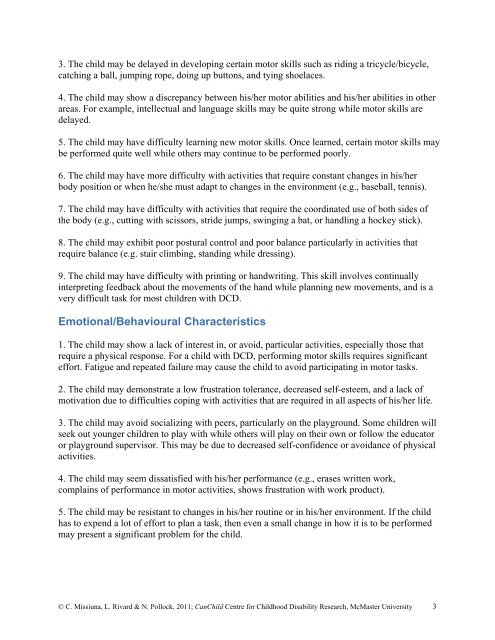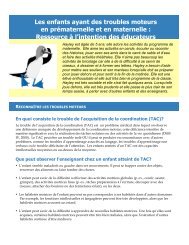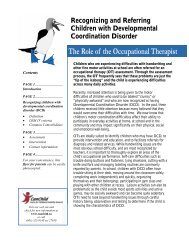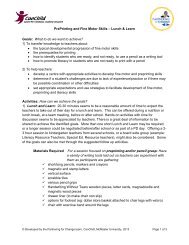Children with Developmental Coordination Disorder - CanChild ...
Children with Developmental Coordination Disorder - CanChild ...
Children with Developmental Coordination Disorder - CanChild ...
You also want an ePaper? Increase the reach of your titles
YUMPU automatically turns print PDFs into web optimized ePapers that Google loves.
3. The child may be delayed in developing certain motor skills such as riding a tricycle/bicycle,catching a ball, jumping rope, doing up buttons, and tying shoelaces.4. The child may show a discrepancy between his/her motor abilities and his/her abilities in otherareas. For example, intellectual and language skills may be quite strong while motor skills aredelayed.5. The child may have difficulty learning new motor skills. Once learned, certain motor skills maybe performed quite well while others may continue to be performed poorly.6. The child may have more difficulty <strong>with</strong> activities that require constant changes in his/herbody position or when he/she must adapt to changes in the environment (e.g., baseball, tennis).7. The child may have difficulty <strong>with</strong> activities that require the coordinated use of both sides ofthe body (e.g., cutting <strong>with</strong> scissors, stride jumps, swinging a bat, or handling a hockey stick).8. The child may exhibit poor postural control and poor balance particularly in activities thatrequire balance (e.g. stair climbing, standing while dressing).9. The child may have difficulty <strong>with</strong> printing or handwriting. This skill involves continuallyinterpreting feedback about the movements of the hand while planning new movements, and is avery difficult task for most children <strong>with</strong> DCD.Emotional/Behavioural Characteristics1. The child may show a lack of interest in, or avoid, particular activities, especially those thatrequire a physical response. For a child <strong>with</strong> DCD, performing motor skills requires significanteffort. Fatigue and repeated failure may cause the child to avoid participating in motor tasks.2. The child may demonstrate a low frustration tolerance, decreased self-esteem, and a lack ofmotivation due to difficulties coping <strong>with</strong> activities that are required in all aspects of his/her life.3. The child may avoid socializing <strong>with</strong> peers, particularly on the playground. Some children willseek out younger children to play <strong>with</strong> while others will play on their own or follow the educatoror playground supervisor. This may be due to decreased self-confidence or avoidance of physicalactivities.4. The child may seem dissatisfied <strong>with</strong> his/her performance (e.g., erases written work,complains of performance in motor activities, shows frustration <strong>with</strong> work product).5. The child may be resistant to changes in his/her routine or in his/her environment. If the childhas to expend a lot of effort to plan a task, then even a small change in how it is to be performedmay present a significant problem for the child.© C. Missiuna, L. Rivard & N. Pollock, 2011; <strong>CanChild</strong> Centre for Childhood Disability Research, McMaster University 3







